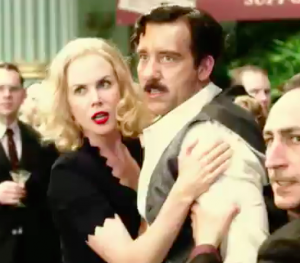The Real Story: Martha Gellhorn and Ernest Hemingway
Posted on May 29, 2012 at 3:32 pm
 HBO’s new movie “Hemingway and Gellhorn,” premiering this week, stars Clive Owen and Nicole Kidman and is directed by Philip Kaufman (“The Right Stuff,” “The Unbearable Lightness of Being”). Today Ernest Hemingway is revered as one of the formost authors of the 20th century for his spare, masculine stories like For Whom the Bell Tolls, The Sun Also Rises, and A Farewell to Arms. Martha Gellhorn, who became his third wife, was a pioneering journalist and war correspondent who covered armed conflict around the world for five decades. Some of her writing is collected in The Face of War
HBO’s new movie “Hemingway and Gellhorn,” premiering this week, stars Clive Owen and Nicole Kidman and is directed by Philip Kaufman (“The Right Stuff,” “The Unbearable Lightness of Being”). Today Ernest Hemingway is revered as one of the formost authors of the 20th century for his spare, masculine stories like For Whom the Bell Tolls, The Sun Also Rises, and A Farewell to Arms. Martha Gellhorn, who became his third wife, was a pioneering journalist and war correspondent who covered armed conflict around the world for five decades. Some of her writing is collected in The Face of War. She wrote a memoir called Travels with Myself and Another and there is a biography by Caroline Moorehead called Gellhorn: A Twentieth-Century Life.
Unabashedly anti-war and politically left-wing, Gellhorn met First Lady Eleanor Roosevelt when she was working as a government investigator reporting on the Depression for the Federal Emergency Relief Administration and they became close friends. She was on her way to report on the Spanish Civil War for Collier’s magazine when she met Hemingway and they went to Barcelona together. She also wrote about the rise of Hitler and WWII battles including D-Day, which she covered by pretending to be a stretcher bearer. And she was one of the first to write about the Dachau concentration camp. Hemingway admired her courage, intelligence and talent but did not like her absences while she was reporting. Their years together were scrappy and they both had affairs with others. She refused to discuss him in later years as she continued to cover conflicts through the war in Vietnam and wrote fiction and non-fiction. But today she is best remembered as the only one of Hemingway’s four wives to ask him for a divorce and the inspiration for the character of Maria in For Whom the Bell Tolls. Hemingway committed suicide in 1961. Gellhorn, blind and ill, also committed suicide, in 1998.
Critic Odie Henderson describes the HBO film as corny but entertaining:
This is Kidman’s best work in years, smart, brassy, funny, sexy and tough. She brings her A-game because Owen’s showier role must be legendary, a larger than life evocation of masculinity suited for the name Hemingway. Cinematographer Rogier Stoffers introduces Owen in a desaturated fishing sequence that culminates in an explosion of bright red blood. Owen’s Hemingway grabs the bull by the horns, resisting cliché just barely enough to feel the breath of caricature on his neck.
